Balkinization
an unanticipated consequence of
Jack M. Balkin
Balkinization Symposiums: A Continuing List
E-mail:
Jack Balkin:
jackbalkin at yahoo.com
Bruce Ackerman
bruce.ackerman at yale.edu
Ian Ayres
ian.ayres at yale.edu
Corey Brettschneider
corey_brettschneider at brown.edu
Mary Dudziak
mary.l.dudziak at emory.edu
Joey Fishkin
joey.fishkin at gmail.com
Heather Gerken heather.gerken at yale.edu
Abbe Gluck abbe.gluck at yale.edu
Mark Graber
mgraber at law.umaryland.edu
Stephen Griffin
sgriffin at tulane.edu
Jonathan Hafetz
jonathan.hafetz at shu.edu
Jeremy Kessler
jkessler at law.columbia.edu
Andrew Koppelman
akoppelman at law.northwestern.edu
Marty Lederman
msl46 at law.georgetown.edu
Sanford Levinson
slevinson at law.utexas.edu
David Luban
david.luban at gmail.com
Gerard Magliocca
gmaglioc at iupui.edu
Jason Mazzone
mazzonej at illinois.edu
Linda McClain
lmcclain at bu.edu
John Mikhail
mikhail at law.georgetown.edu
Frank Pasquale
pasquale.frank at gmail.com
Nate Persily
npersily at gmail.com
Michael Stokes Paulsen
michaelstokespaulsen at gmail.com
Deborah Pearlstein
dpearlst at yu.edu
Rick Pildes
rick.pildes at nyu.edu
David Pozen
dpozen at law.columbia.edu
Richard Primus
raprimus at umich.edu
K. Sabeel Rahmansabeel.rahman at brooklaw.edu
Alice Ristroph
alice.ristroph at shu.edu
Neil Siegel
siegel at law.duke.edu
David Super
david.super at law.georgetown.edu
Brian Tamanaha
btamanaha at wulaw.wustl.edu
Nelson Tebbe
nelson.tebbe at brooklaw.edu
Mark Tushnet
mtushnet at law.harvard.edu
Adam Winkler
winkler at ucla.edu
Compendium of posts on Hobby Lobby and related cases
The Anti-Torture Memos: Balkinization Posts on Torture, Interrogation, Detention, War Powers, and OLC
The Anti-Torture Memos (arranged by topic)
Recent Posts
Party Divisions and the Separation of Powers
Just A Few Blogs
ACS Blog
Alas, a Blog
Althouse
Arts and Letters Daily
Atrios (Eschaton)
Bill of Health
Buzzflash.com
Buzz Machine
Cato at Liberty
Juan Cole (Informed Comment)
Concurring Opinions
The Constitution in 2020
Corrente
Crooked Timber
Daily Howler
Daily Kos
Dana Boyd
Brad DeLong
Digby (Hullabaloo)
Discriminations
Daniel Drezner
Kevin Drum (Mother Jones)
Electrolite
En Banc
Eunomia (Daniel Larison)
Fafblog
Michael Froomkin (Discourse.net)
GovLab (Beth Noveck)
Rick Hasen (Election Law)
History News Network
How Appealing
Ignatz (Sam Heldman)
The Importance of (Ernie Miller)
Infolaw
Instapundit
International Economic Law and Policy Blog
IntLawGrrls
Jacob Levy
Jesus' General
Jurisdynamics
The Kitchen Cabinet
Mark Kleiman
Law Blog Central
Larry Lessig
Lawyers, Guns and Money
Liberal Oasis
Brian Leiter's Law School Reports
The Leiter Reports
Marginal Revolution
Megan McArdle
Memeorandum
Metafilter
Mirror of Justice
The New Republic
Newseum
No More Mister Nice Blog
Brendan Nyhan
Opinio Juris
Orcinus
The Originalism Blog
Pandagon
Passport (Foreign Policy)
Overcoming Bias
Political Animal (Washington Monthly)
Political Theory Daily Review
Political Wire (Taegan Goddard)
The Poor Man
Virginia Postrel
Prawfsblawg
Public Reason
Jonathan Rauch
Raw Story
Redstate
ReligiousLeftLaw.com
Reporters Committee For Freedom of the Press
Reproductive Rights Blog
Rothman's Roadmap to the Right of Publicity
SCOTUS Blog
Seeing the Forest
Clay Shirky
The Shifted Librarian
The Situationist
Larry Solum (Legal Theory)
Andrew Sullivan
Talking Points Memo
Talk Left
Tapped
Tbogg
TechPresident
The Paper Chase (Jurist)
Tom Paine
Tom Tomorrow (This Modern World)
Eve Tushnet
Uggabugga
University of Chicago Law School Faculty Blog
Unqualified Offerings
The Volokh Conspiracy
War and Piece (Laura Rozen)
Wampum
Oliver Willis
Wonkette
Written Description
Matthew Yglesias
Yin
Your Choice of Feeds
1. XML
powered by
2. Atom Feed
3. RSS 2.0
Tuesday, September 22, 2020
Party Divisions and the Separation of Powers
Guest Blogger
Gregory Elinson Hours after the Supreme
Court announced Friday night that Justice Ruth Bader Ginsburg had died, Senate
Majority Leader Mitch McConnell (R-KY) promised that President Donald
Trump’s nominee to fill her seat would be assured a floor vote. But earlier
that same Friday, Republican
Senator Lisa Murkowski (R-AK) told reporters: “I would not vote to confirm
a Supreme Court nominee…50-some days away from an election.” At least one other
Senate Republican—Susan
Collins (R-ME)—has since said there should be no vote on Ginsburg’s
replacement before the presidential election, while Mitt
Romney (R-UT) remains non-committal.
All of this jockeying doesn’t quite reflect how we tend to think partisanship
should work in today’s polarized environment. The story we
usually tell is that Democrats and Republicans in Congress march in lockstep
against each other. But that’s not always—or even often—how our system
works. The fight over who will get to name Ginsburg’s replacement is just the
latest battle to divide members of the same party. For citizens and
lawyers, these divisions have important stakes for how the Constitution works
in practice. And it should point our collective attention to what is often the
exclusive province of political scientists (but shouldn’t be): the financial
and electoral incentives that senators who share the same party affiliation
have to work together, as well as the rules and procedures that shape their
collective and coordinated action. Checks and Balances We usually worry that the checks and balances at the core of our
constitutional system are rendered toothless when the same party controls both
Congress and the White House. The thinking goes that Congress will just rubber
stamp the president’s agenda. But that turns out to be wrong if the party in
control of the legislative branch can’t hold together. When presidents face a
friendly—but disorganized—Congress, they may have far less power than we
sometimes fear to alter the status quo. If the party in power (and the
interests that constitute it) are happy to keep things as they are, this isn’t
such a loss. But if a president is seeking to implement an ambitious agenda, be
it progressive or retrenching, he may be out of luck. Recent history is a good guide. Consider, for example, that
despite controlling both chambers of Congress and the White House,
congressional Republicans repeatedly
failed to make good on their campaign promise to roll back the Affordable
Care Act. Why? They couldn’t agree on what would replace it. While members of the House
Freedom Caucus and the Senate’s most conservative Republicans demanded
wholesale repeal, members of the moderate Tuesday Group and centrists in the
upper chamber insisted on a replacement that would keep their constituents’
coverage intact. Indeed, absent agreement on what would come after the ACA,
Republicans ultimately found common ground on the one thing they knew had to
go: the individual mandate. By the same token, we often believe that checks and balances will
function well when partisan control of Congress and the White House is split. We
tell ourselves that dislike of the other party will be sufficient to motivate
interbranch competition. Again, though, the picture changes when the party in
control of Congress can’t hold together. If members of the majority party can’t
reach accord, we shouldn’t be so sanguine they’ll muster the collective
strength to stand up to the president. Consider that disagreements
among Democrats delayed the House opening an impeachment inquiry against
Trump for many months and limited
the scope of the charges ultimately brought against him. The more that presidents
can do to exploit these cracks, the more likely it is they’ll be able to get their
way—even when facing an unfriendly Congress.
In this sense, party fractures undermine the separation of powers by
weakening the possibility that partisan animosity will do what institutional
loyalty typically doesn’t. Party Cohesion Matters All of this means that the separation of powers turns on how well
parties stick together. And that depends (1) on how well party leaders use
their tools of office, and (2) on a number of institutional and electoral
incentives that drive party cohesion. Cameral and Caucus-Based Rules and Norms To begin, both House and Senate leaders play a key role in
determining what goes on their respective chambers’ agenda. To do this, they
employ a variety of parliamentary tools: moving bills off the legislative
calendar, recognizing speakers, and deciding what kinds of amendments can be
considered—to name only a few. Majority party leaders often use their control
of the legislative agenda to block issues that divide the party from reaching
the floor for debate, let alone a controversial vote. And within both parties,
leaders rely on a range of procedures to minimize the appearance, if not the
reality, of party conflict. Think here of the Republicans’ Hastert
Rule and the Democrats’
Steering and Policy Committee, both of which are used to sort out factional
disagreements and to avoid public displays of disunity. As lawyers, we don’t usually think these tools have much
constitutional significance. But as the fight over Ginsburg’s replacement may
well show, that’s a mistake. In fact, these cameral rules and party procedures matter
a great deal for how the separation of powers actually works. Institutional and Electoral Incentives Next up are an array of institutional and electoral incentives that shape
party cohesion, or its absence. Here, the media matters. Particularly on the
Republican side of the aisle, an
array of evidence suggests that officeholders are increasingly
“intertwined” with conservative media outlets. As political scientists Paul
Pierson and Eric Schickler observe, these relationships are characterized by
“increasingly open coordination and exchange of personnel.” So does money, although its influence is less clear. On the one hand, party loyalty is often
rewarded financially. McConnell,
for instance, is a prodigious fundraiser, helping to raise over $117
million for the Senate Leadership Fund. On the other, the current campaign
finance regime privileges individual candidates over party structures. This
means that rebel senators can potentially offset the costs of their disloyalty
by cultivating new sources of cash. Of course, the question is whether some of
the most prominent ideologically motivated donors—Sheldon Adelson, for example—are
willing to open their wallets for prominent dissidents. Finally, there are electoral calculations. Particularly for
vulnerable incumbents, there are no costless options. Should they tack to the
base by demonstrating their party bona fides, they risk alienating the
persuadable voters in their states. However few truly “swing” voters remain, it
is clear from the 2016 presidential election that Obama-Trump
voters arguably decided the election, and polling
from states like Montana suggests that there may still be some split-ticket
voters. Should they make clear their independence from the party, they
risk being tarred as insufficiently committed to the party’s cause—or, worse,
flip-floppers. And there is at least some evidence that Republican voters, in
particular, punish this kind of finger-in-the-wind politicking. Whatever
strategy they choose, incumbents also have to find jobs if they lose. While
party loyalty might lead to plumb lobbying or media posts, a reputation as a
party maverick can also lead to a lasting legacy, as John McCain’s late career
suggests. So What Happens With Ginsburg’s Replacement? With several senators already expressing discomfort with a swift
vote on Ginsburg’s replacement, McConnell has little room to maneuver. After
urging his colleagues to “keep
their powder dry” for the fight ahead, he’s devoted much of his energy over
the past few days to persuading Senate Republicans that a vote to confirm a
Trump pick is justified. But whether or not McConnell will be able to deliver
another Republican-appointed Justice to the Supreme Court remains in doubt. Will
the Republican holdouts bend to the party whip? Will Senate Democrats use the
chamber’s rules to deny the majority leader a quorum? For potential Republican dissidents, the difficulty of their
choice is evidenced by the divergent approaches of vulnerable incumbents
Collins and Lindsay Graham (R-SC). While Collins followed Murkowski in saying there
should be no vote on Ginsburg’s successor, Graham has taken the
opposite tack. These dynamics reveal a core truth about our constitutional
system. Though we tend to think that party conflict rules the day, the future
of our democracy and the stability of the Supreme Court may hang instead on how
the GOP manages disagreement within its own ranks. We often think that
McConnell’s success in confirming Trump’s judicial nominees reflects party
strength. But if McConnell succeeds in wrangling a majority to confirm
Ginsburg’s replacement, it’s worth asking instead why it is that the politics
of judicial appointments may be so effective at bridging the party’s
differences. Gregory Elinson is a
Climenko Fellow at Harvard Law School. You can reach him by e-mail at gelinson@law.harvard.edu.
Posted
9:00 AM
by Guest Blogger [link]
Books by Balkinization Bloggers

Linda C. McClain and Aziza Ahmed, The Routledge Companion to Gender and COVID-19 (Routledge, 2024)

David Pozen, The Constitution of the War on Drugs (Oxford University Press, 2024)

Jack M. Balkin, Memory and Authority: The Uses of History in Constitutional Interpretation (Yale University Press, 2024)
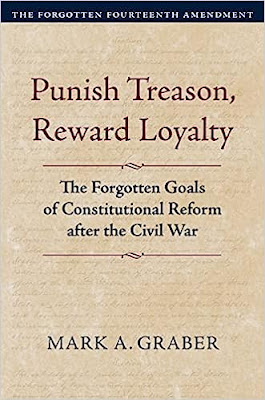
Mark A. Graber, Punish Treason, Reward Loyalty: The Forgotten Goals of Constitutional Reform after the Civil War (University of Kansas Press, 2023)
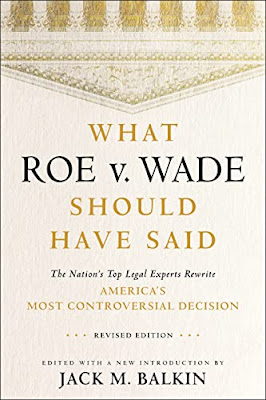
Jack M. Balkin, What Roe v. Wade Should Have Said: The Nation's Top Legal Experts Rewrite America's Most Controversial Decision - Revised Edition (NYU Press, 2023)

Andrew Koppelman, Burning Down the House: How Libertarian Philosophy Was Corrupted by Delusion and Greed (St. Martin’s Press, 2022)

Gerard N. Magliocca, Washington's Heir: The Life of Justice Bushrod Washington (Oxford University Press, 2022)
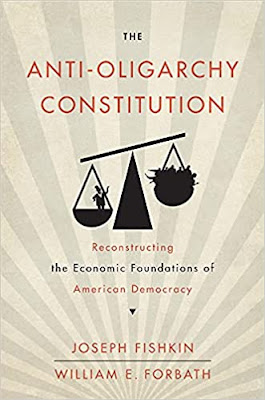
Joseph Fishkin and William E. Forbath, The Anti-Oligarchy Constitution: Reconstructing the Economic Foundations of American Democracy (Harvard University Press, 2022)
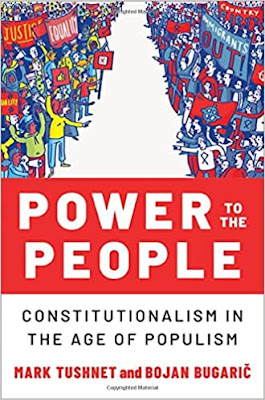
Mark Tushnet and Bojan Bugaric, Power to the People: Constitutionalism in the Age of Populism (Oxford University Press 2021).

Mark Philip Bradley and Mary L. Dudziak, eds., Making the Forever War: Marilyn B. Young on the Culture and Politics of American Militarism Culture and Politics in the Cold War and Beyond (University of Massachusetts Press, 2021).

Jack M. Balkin, What Obergefell v. Hodges Should Have Said: The Nation's Top Legal Experts Rewrite America's Same-Sex Marriage Decision (Yale University Press, 2020)

Frank Pasquale, New Laws of Robotics: Defending Human Expertise in the Age of AI (Belknap Press, 2020)

Jack M. Balkin, The Cycles of Constitutional Time (Oxford University Press, 2020)

Mark Tushnet, Taking Back the Constitution: Activist Judges and the Next Age of American Law (Yale University Press 2020).

Andrew Koppelman, Gay Rights vs. Religious Liberty?: The Unnecessary Conflict (Oxford University Press, 2020)

Ezekiel J Emanuel and Abbe R. Gluck, The Trillion Dollar Revolution: How the Affordable Care Act Transformed Politics, Law, and Health Care in America (PublicAffairs, 2020)

Linda C. McClain, Who's the Bigot?: Learning from Conflicts over Marriage and Civil Rights Law (Oxford University Press, 2020)
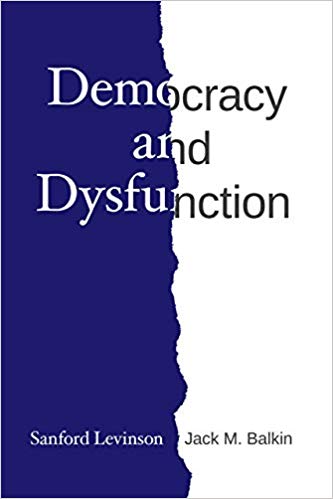
Sanford Levinson and Jack M. Balkin, Democracy and Dysfunction (University of Chicago Press, 2019)

Sanford Levinson, Written in Stone: Public Monuments in Changing Societies (Duke University Press 2018)

Mark A. Graber, Sanford Levinson, and Mark Tushnet, eds., Constitutional Democracy in Crisis? (Oxford University Press 2018)

Gerard Magliocca, The Heart of the Constitution: How the Bill of Rights became the Bill of Rights (Oxford University Press, 2018)

Cynthia Levinson and Sanford Levinson, Fault Lines in the Constitution: The Framers, Their Fights, and the Flaws that Affect Us Today (Peachtree Publishers, 2017)

Brian Z. Tamanaha, A Realistic Theory of Law (Cambridge University Press 2017)

Sanford Levinson, Nullification and Secession in Modern Constitutional Thought (University Press of Kansas 2016)

Sanford Levinson, An Argument Open to All: Reading The Federalist in the 21st Century (Yale University Press 2015)

Stephen M. Griffin, Broken Trust: Dysfunctional Government and Constitutional Reform (University Press of Kansas, 2015)

Frank Pasquale, The Black Box Society: The Secret Algorithms That Control Money and Information (Harvard University Press, 2015)

Bruce Ackerman, We the People, Volume 3: The Civil Rights Revolution (Harvard University Press, 2014)
Balkinization Symposium on We the People, Volume 3: The Civil Rights Revolution

Joseph Fishkin, Bottlenecks: A New Theory of Equal Opportunity (Oxford University Press, 2014)

Mark A. Graber, A New Introduction to American Constitutionalism (Oxford University Press, 2013)

John Mikhail, Elements of Moral Cognition: Rawls' Linguistic Analogy and the Cognitive Science of Moral and Legal Judgment (Cambridge University Press, 2013)

Gerard N. Magliocca, American Founding Son: John Bingham and the Invention of the Fourteenth Amendment (New York University Press, 2013)

Stephen M. Griffin, Long Wars and the Constitution (Harvard University Press, 2013)

Andrew Koppelman, The Tough Luck Constitution and the Assault on Health Care Reform (Oxford University Press, 2013)

James E. Fleming and Linda C. McClain, Ordered Liberty: Rights, Responsibilities, and Virtues (Harvard University Press, 2013)
Balkinization Symposium on Ordered Liberty: Rights, Responsibilities, and Virtues

Andrew Koppelman, Defending American Religious Neutrality (Harvard University Press, 2013)

Brian Z. Tamanaha, Failing Law Schools (University of Chicago Press, 2012)

Sanford Levinson, Framed: America's 51 Constitutions and the Crisis of Governance (Oxford University Press, 2012)

Linda C. McClain and Joanna L. Grossman, Gender Equality: Dimensions of Women's Equal Citizenship (Cambridge University Press, 2012)

Mary Dudziak, War Time: An Idea, Its History, Its Consequences (Oxford University Press, 2012)

Jack M. Balkin, Living Originalism (Harvard University Press, 2011)

Jason Mazzone, Copyfraud and Other Abuses of Intellectual Property Law (Stanford University Press, 2011)

Richard W. Garnett and Andrew Koppelman, First Amendment Stories, (Foundation Press 2011)

Jack M. Balkin, Constitutional Redemption: Political Faith in an Unjust World (Harvard University Press, 2011)

Gerard Magliocca, The Tragedy of William Jennings Bryan: Constitutional Law and the Politics of Backlash (Yale University Press, 2011)

Bernard Harcourt, The Illusion of Free Markets: Punishment and the Myth of Natural Order (Harvard University Press, 2010)

Bruce Ackerman, The Decline and Fall of the American Republic (Harvard University Press, 2010)
Balkinization Symposium on The Decline and Fall of the American Republic

Ian Ayres. Carrots and Sticks: Unlock the Power of Incentives to Get Things Done (Bantam Books, 2010)

Mark Tushnet, Why the Constitution Matters (Yale University Press 2010)
Ian Ayres and Barry Nalebuff: Lifecycle Investing: A New, Safe, and Audacious Way to Improve the Performance of Your Retirement Portfolio (Basic Books, 2010)
.jpg)
Jack M. Balkin, The Laws of Change: I Ching and the Philosophy of Life (2d Edition, Sybil Creek Press 2009)

Brian Z. Tamanaha, Beyond the Formalist-Realist Divide: The Role of Politics in Judging (Princeton University Press 2009)

Andrew Koppelman and Tobias Barrington Wolff, A Right to Discriminate?: How the Case of Boy Scouts of America v. James Dale Warped the Law of Free Association (Yale University Press 2009)

Jack M. Balkin and Reva B. Siegel, The Constitution in 2020 (Oxford University Press 2009)
Heather K. Gerken, The Democracy Index: Why Our Election System Is Failing and How to Fix It (Princeton University Press 2009)

Mary Dudziak, Exporting American Dreams: Thurgood Marshall's African Journey (Oxford University Press 2008)

David Luban, Legal Ethics and Human Dignity (Cambridge Univ. Press 2007)

Ian Ayres, Super Crunchers: Why Thinking-By-Numbers is the New Way to be Smart (Bantam 2007)

Jack M. Balkin, James Grimmelmann, Eddan Katz, Nimrod Kozlovski, Shlomit Wagman and Tal Zarsky, eds., Cybercrime: Digital Cops in a Networked Environment (N.Y.U. Press 2007)

Jack M. Balkin and Beth Simone Noveck, The State of Play: Law, Games, and Virtual Worlds (N.Y.U. Press 2006)

Andrew Koppelman, Same Sex, Different States: When Same-Sex Marriages Cross State Lines (Yale University Press 2006)
Brian Tamanaha, Law as a Means to an End (Cambridge University Press 2006)
Sanford Levinson, Our Undemocratic Constitution (Oxford University Press 2006)
Mark Graber, Dred Scott and the Problem of Constitutional Evil (Cambridge University Press 2006)
Jack M. Balkin, ed., What Roe v. Wade Should Have Said (N.Y.U. Press 2005)
Sanford Levinson, ed., Torture: A Collection (Oxford University Press 2004)
Balkin.com homepage
Bibliography
Conlaw.net
Cultural Software
Writings
Opeds
The Information Society Project
BrownvBoard.com
Useful Links
Syllabi and Exams